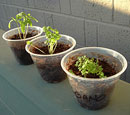Soaring food prices, a hunger for locally grown produce, high obesity rates, and the desire by people to reconnect with nature and with each other have sparked a national renaissance in community gardening. As part of this movement, school gardens are sprouting up everywhere. Teachers are using these green spaces to teach a variety of subjects, including horticulture, nutrition, history, science, math, writing, and art.
The School Garden Movement
The idea of incorporating gardens in schools began in the late 19th century when Henry Lincoln Clapp, a teacher at the George Putnam Grammar School in Boston, MA, established the first school garden. Inspired after visiting school gardens in Europe, Clapp created a wildflower and vegetable garden at Putnam in 1891 with support from the Massachusetts Horticultural Society. The establishment of school gardens soon spread throughout the state and eventually became a nationwide movement, with an estimated 75,000 school gardens by 1906.
For garden advocates, integrating school gardens in the public schools served many purposes. It was a way to get city children outside, engage them in physical activity, and instill in them a sense of pride and teamwork as they cultivated and maintained their gardens. Gardening classes provided students with vocational and agricultural training. Teachers taught a variety of subjects through garden activities. Students practiced writing by keeping planting journals and writing compositions about the garden. Math skills were acquired by counting seeds, measuring garden plots, and determining the appropriate soil depth for planting. Students learned botany and entomology by observing plants and insects and their interrelationships. Geography and history came into play when students studied the origins of fruits and vegetables and planting customs among different cultures. The gardens provided inspiration for drawing, painting, and performing music. In 1914, the federal government established the Bureau of Education’s Office of School and Home Gardening, which promoted school gardens and provided “how-to” pamphlets and course guides.
The School Garden Army
Children’s involvement in gardening took on a new urgency when the United States entered World War I in 1917. In order to provide food to European allies facing a food crisis and to U.S. troops fighting overseas, citizens were encouraged to grow food for domestic consumption as part of the war garden campaign. Children were enlisted to join the School Garden Army, which adopted the motto, “A garden for every child, every child in a garden.” Students became important contributors to the garden campaign, growing thousands of dollars worth of produce in their school and home gardens.
Victory Gardens of World War II
When the United States entered World War II, children once again played an active role in growing fruits and vegetables to assist in the war effort. During the war, citizens were encouraged to establish victory gardens in their backyards, vacant lots, and schools to provide food for civilians and troops. Gardening was also promoted to boost morale, encourage physical activity and healthy eating and to help Americans deal with the stresses of war. The U.S. Office of Education encouraged victory gardening at schools and promoted school lunch programs that served locally grown fresh fruits and vegetables. The Boy Scouts of America, 4-H clubs, parks and recreation departments, churches, and many civic organizations were involved in victory gardening programs for children. In 1944, the U.S. Department of Agriculture reported that victory gardens produced 40 percent of the vegetables that were consumed nationally.
Community Garden Movement of the 1970s
The post-war suburban housing boom of the 1950s and 1960s generated more interest in backyard gardening than in community gardening. This changed in the 1970s when rising food prices, an increase in environmental awareness, and a desire by citizens to revitalize neighborhoods plagued by crime and neglect sparked a new community garden movement. Citizens and non-profit groups, such as Boston Urban Gardeners and New York’s Green Guerillas, turned vacant lots into colorful, productive green spaces. The U.S. Department of Agriculture initiated the Urban Garden Program in 1976 to help residents in major cities grow their own food. Educators and activists who were concerned that children were disconnected from nature and unaware of where their food came from reached out to young people and encouraged them to participate in neighborhood, youth, and school gardens. In a 1974 article in the Washington Post, writer Henry Mitchell noted that in Washington, DC, “there are 1,000 small gardens about town in which children grow such plants as the radish, the onion, and (as the weather stops being barbarous) the tomato.”
Growing Popularity of School Gardens
Since the 1970s, the popularity of school and youth gardens has grown steadily. California took the lead in 1995 by launching the “Garden in Every School” program. As in the school garden movement of the late 19th and early 20th centuries, teachers are utilizing these outdoor classrooms to teach a wide range of academic subjects through hands-on experiential activities. In addition, educators are using school gardens to encourage a healthier lifestyle, promote environmental stewardship and provide students with the opportunity to develop leadership and team-building skills.
These free resources provide ideas on how to incorporate school gardens into the academic curriculum, including social studies:
